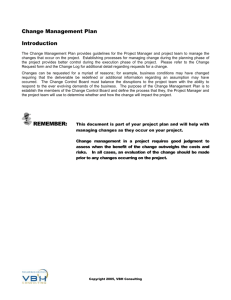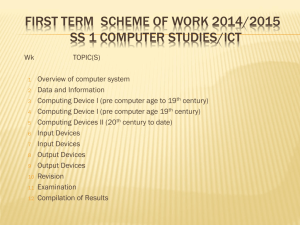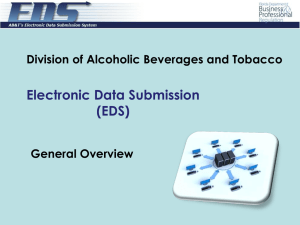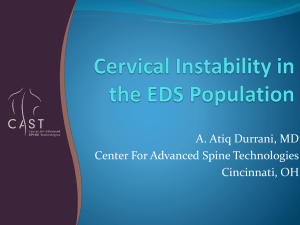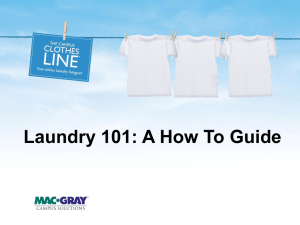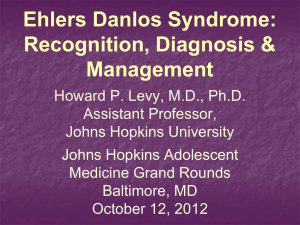Occupational Therapy Management of Hypermobility in Ehlers
advertisement
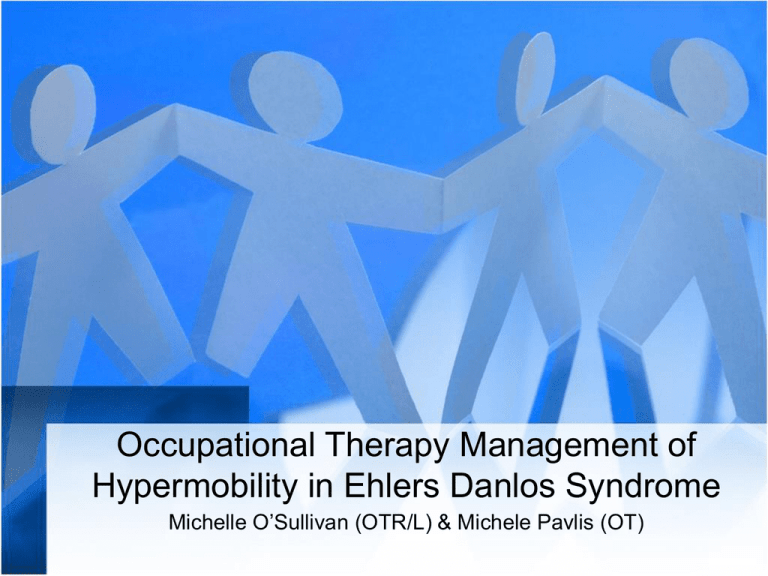
Occupational Therapy Management of Hypermobility in Ehlers Danlos Syndrome Michelle O’Sullivan (OTR/L) & Michele Pavlis (OT) About Us EDNF Conference 2010 We re-unite EDNF 2011 & the idea of this presentation is born! What is Occupational Therapy? Occupation: the roles you play in your life and the performance of tasks and activities than enable you to fulfill those roles Therapy: enabling you to fulfill your roles and find meaning in your activities Who do we work with? Team Approach – We work WITH: • Physical Therapists • Speech Therapists • Psychologists • Doctors & Physicians • Social Workers & Counselors What is the aim of OT? • to promote and maintain your independence in as many aspects of your life as possible How do I get seen by an OT? • Referral / Script from your Doctor • You will need to request this from your Doctor as not all medical professionals understand OT roles and services which are helpful for people with EDS • You need to specify to your Doctor that you require a full assessment of your activities of daily living What might the OT do for me? • Initial Assessment / Evaluation • Make splints • Order assistive devices / equipment through your insurance • If necessary, they may do a home assessment • Make recommendations for modifications or other equipment that you may benefit from • Help with problem solving and cognitive strategies • Recommendations for exercises and activity modification continued... An OT can help you • access programs and services in your community • build and maintain your support systems What can an OT do for someone with hypermobility? Mind Body Spirit Emotion People usually present with PHYSICAL difficulties: after joint dislocations/ subluxations with pain fatigue gastrointestinal problems mobility issues Initial Assessment Cognitive Physical Social Emotional Spiritual Energy Conservation “We need to learn to move efficiently so that we can save our limited energy for the important things” Energy Conservation continued… • keep frequently used items in a special place which is always the same place! • write checklists • keep everyday items such as cutlery, plate & bowl and glass at waist level Continued… • make use of online shopping for groceries, or do multiple small shopping trips per week OR – take a friend with you to help & save a trip! • use a small bag to put frequently used items in USE YOUR BRAIN to SAVE YOUR BODY Pain Management Just because our thoughts impact our pain… It doesn't mean the pain is ‘all in our heads’ (as we think we hear people tell us) It doesn't mean that we are somehow willing the pain and making it happen It doesn't mean that if we have complete control of our thoughts and always think positively, that pain won't occur Continued… HOWEVER…. Some ideas: • Keeping a thought diary • Working out our instinctual response to pain – Do I fear pain? - Do I gain something from it? – Do I dwell on it? - Do I get fixated on it? – Do I catastrophize? - Will people believe me? • Thought management – Is my thought helpful? - Is it a hindrance? – How true is what I’m saying to myself? • Other strategies Other strategies for pain management • Relaxation / meditation • Diversional therapy • Goal setting & rewards Relaxation & meditation • Takes practice • Particularly helpful strategy for falling asleep • Commercially available vs. pain management specific • The Gratefulness Alphabet Diversional therapy • Watching TV/ DVDs • Listening to or playing music • Reading • Meeting up with friends or family and doing something/chatting • Painting • Craft • Going to the movies • Baking/cooking •Painting your nails (girls) •Playing games, digital or board games •Chatting over the phone or Skype with a friend •Watching sport •Enjoying nature •DIY jobs, home projects Other therapies & modalities • • • • • • • • • • • Heat or ice packs Aquatic Therapy Physical Therapy Cranio-Sacral Therapy Reiki and Healing Therapies Massage therapy Acupuncture Pilates Tai Chi Dry Needling Trigger Point Injections Goal Setting (an OT’s favorite thing) Rewards • Intrinsic = internal reward “I did a great job & I’m proud” • Extrinsic = external reward “I’m going to buy myself a new dress because I did that so well” • Motivating • Appropriate Joint Protection Techniques before you start, or as soon as you remember thereafter Should I be doing this at all? If yes, how should I do this to minimize risk of injury? Can I do this another way? What joints am I using, which ones do I need to protect, or which stabilizing muscles do I need to switch on to do this safely? Am I going to go into my hypermobile range/hyperextension to do this? Can I cope with any consequences? Be particularly careful if you are doing anything involving •Weight •Repetition •High impact •Prolonged static positions Only if you have worked out the best way to do the task… if you should be doing it at all!! Home Set Up & Equipment Checklist • • • • • • Kitchen Bathroom Bedroom Living Room Car Work place / work station Kitchen • Check countertop height • Easily accessible utensils and frequently used items • Minimise the weight of appliances and other items like pots & pans • Be careful of how heavy food/drink items are that you purchase at the shops Bathroom • Is it SAFE? • Can you reach things? • Do you need some assistive devices to help you bathe independently? Bedroom • Easy access to items used most often • A good mattress & pillow • Decrease the amount of electrical equipment & technology in your room • Make your room as dark as possible to promote sleep Living room • Check the height of your sofa or couch • Are there any trip hazards? Car • Check steering wheel and pedal height • Seat position • Handicap placard Work place / work station • • • • Check desk height Check workstation set up Take breaks Check lighting and airflow Assistive Devices • • • • • • • Meal Preparation Eating Cleaning Bathing Laundry Work / school Other Meal Preparation CanKey Zyliss 5 in 1 opener JarKey Dycem jar opener Dycem Grip Mat Cordless Kettle Tipper Eating Rocker Knife Cylindrical foam Built-up cutlery SHARP knives Trolley/ Cart Cleaning Long handled dustpan & broom Long handled reacher Long handled cleaning brush Cleaning… Robot Vacuum Long handled brush Long handled toilet brush Long handled duster Bathing Toothbrush grip Long handled back sponge Shower Stool Long handled toe washer/dryer Toothpaste dispenser Laundry Easy clothes pins Machine Raiser Drying line Laundry Trolley Work / School Footrest Slope Board Copy holder Laptop dock Gel wrist support Ergonomic Mouse Other Key Turner Swivel Seat Car Handy -bar Other… Tap Turners Meds reminder Blister pack opener Meds organizer Opportunity for change Redefine your purpose Acceptance Spiritual/Emotional Impacts • YOU are not your ability or your dis-ability • Your EDS does NOT define YOU • You are a person WITH EDS, not an EDS patient Continued… • There will be setbacks along the road; life might change direction completely… but WHO YOU ARE does not change • When setbacks occur, we need to redefine our expectations and goals, and reassign our energy, skills and talents to new things An occupational therapist may be just the resource you need to achieve all of this and lead a life that is meaningful to you. Visit the following for more information about OT in your country: www.aota.org (USA) www.cot.co.uk (UK) www.ausot.com.au (Australia) www.caot.ca (Canada) Children’s Book My Bendy Body by Michelle O’Sullivan RRP: US$20 Visit www.hypermobilot.com.au for more info on ordering
